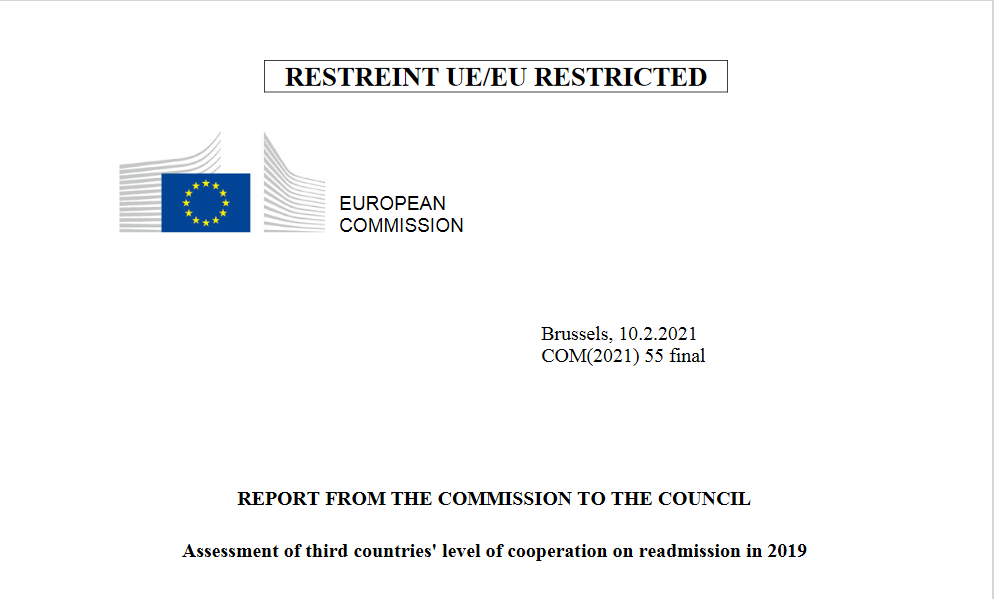Border surveillance, drones and militarisation of the Mediterranean
Topic
Country/Region
06 May 2021
The growing use of drones and other long-range, increasingly-automated forms of surveillance and data collection are part of the militarisation of Europe’s borders in the Mediterranean, which have led to thousands of unnecessary deaths and push- and pull-backs to Libya, where migrants and refugees face arbitrary detention, violence, mistreatment and torture. This article, by the journalist Antonio Mazzeo, chronicles investments into and tests and deployments of drone technology by EU and national agencies in the Mediterranean.
Support our work: become a Friend of Statewatch from as little as £1/€1 per month.
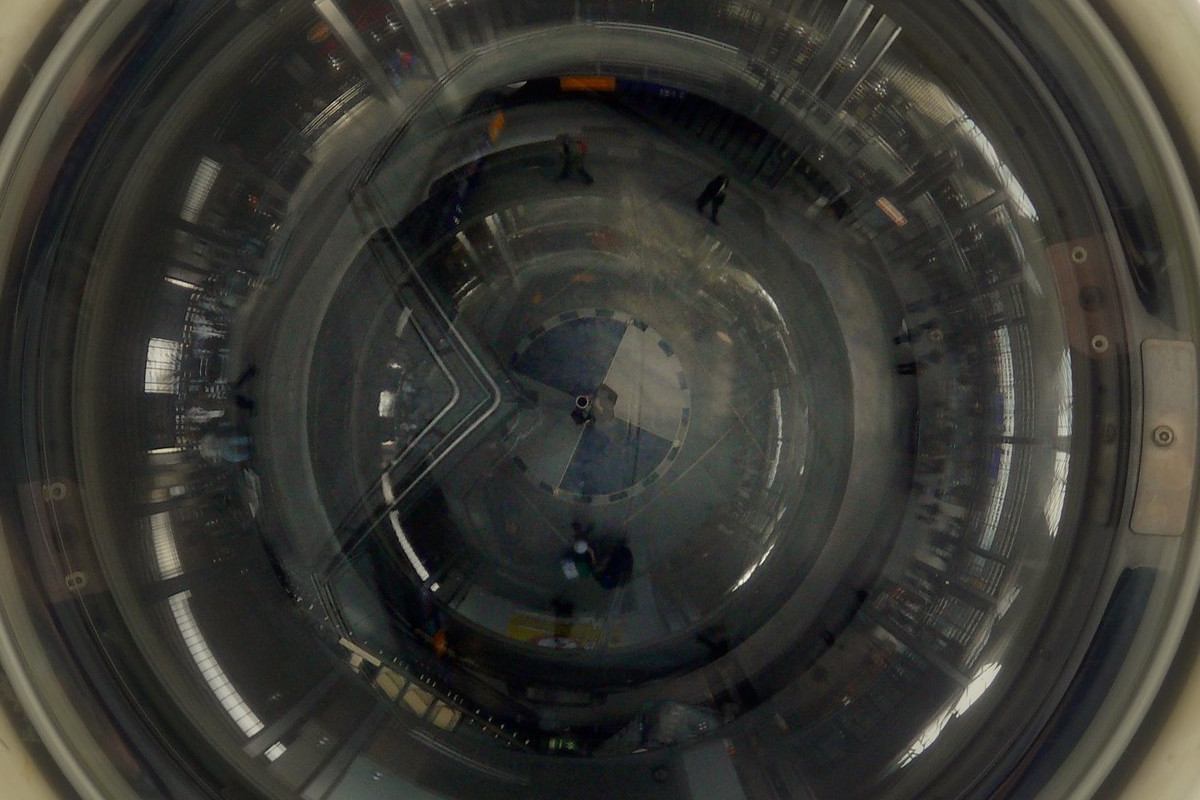
Image: XoMEoX, CC BY-NC 2.0
The original version of this article was published by A-DIF in November 2020 and is based on a presentation given at the seminar ‘War, Migrations and Rights in the Mediterranean’, held by A-DIF in cooperation with ANPI (National Association of Italian Partigiani) and the Department of Formation Sciences of the University of Palermo.
War against migrants with Israeli drones
On 20 October 2020, The Guardian gave the news that Frontex, the European Border and Coast Guard Agency, had entrusted aerospace giant Airbus and two Israeli companies with an “aerial maritime surveillance” service using drones to intercept migrant vessels crossing the Mediterranean. Operations should commence in the first months of 2021, following test trials that the contractors will undertake in the Greek island of Crete. Two contracts were signed, both of them for a value of 50 million Euros: the first one with the consortium Airbus – Israel Aerospace Industries (IAI), and the second one with Elbit Systems Ltd., based in Haifa.[1]
This news was confirmed by the authoritative Israeli newspaper The Jerusalem Post, which also provided unpublished details of the agreement. In particular, it was revealed that Israel Aerospace Industries, the main holding company of the Israeli military-industrial complex, will lease a remote-piloted aircraft for mid-altitude and long-range operations, MALE RPAS (Medium Altitude Long Endurance Remotely Piloted Aerial System), “Heron” class. “The agreement with the Frontex agency of the European Union has the goal of ensuring a maritime patrol and coastal protection service”, The Jerusalem Post reported. “This confirms the trust in the performance of the Heron naval drone that was already tested in Crete in 2018 and in many other operations by the Israeli armed forces”.
The flight routes to be used for flight activities of the pilotless aircraft will be identified within European air space in agreement with the agencies responsible for regulating civilian air traffic. “Being able to fly in European civilian air space is an important step for our industrial group and concrete evidence of the ability of our remote piloting system to move within civilian routes”, declared Moshe Levy, general manager of the aerospace sector of Israel Aerospace Industries. “I am sure,” Levy added, “that this contract will open the gates for other markets in the civilian commercial field for us”.[2]
The terms of reference and the goals of the two contracts signed on 1 October can be viewed online. The first has as its first contractor Airbus DS Airborne Solutions GmbH of Bremen (Germany), a company controlled by Airbus Defence and Space, the military aerospace division of the Airbus group.[3] The contractor will have to provide a Remotely Piloted Aerial System (RPAS) platform with the connected equipment for communications, the collection and transfer of data to a remote portal, mission memorisation, control and assistance by drone operators via radio and satellite connections.
“The service will be provided in Greece, and/or in Italy and/or Malta with the modalities that will be provided in the agreement that will be detailed between Frontex and the contractor”, Frontex explained. “The contract worth €50 million excluding VAT may be entrusted to a subcontractor for up to a quota of 60%, with the provision of an aerial remote-controlled system, satellite telecommunications services and spare equipment for replacements, aircraft maintenance and the formation and training of Airbus DS personnel”.
The European aerospace giant’s choice of the Heron maritime surveillance drone was determined by the aircraft’s technical specifications and by its performance attained during deployment in war theatres and in the maintenance of public order by the Israeli Defence Forces and police forces. Drones from the Heron series have mainly been used against the Palestinian population. In a June 2009 report, the US NGO Human Rights Watch documented the use of Heron aircraft during the Israeli attack on Gaza at the end of 2008 and the start of 2009 (Operation Molten Lead), in which dozens of civilians were killed.[4]
Heron aircraft are also used by the German army in Afghanistan through a leasing contract with Airbus that, as we have seen, is the “European partner” of IAI. However, the drone’s performance on the Afghan chessboard has raised more than a few eyebrows among the military and political forces because, to date, four aircraft have already “gone missing” in missions due to various types of technical incidents. The last of these was in mid-November 2020: a Heron of the Bundeswehr (German Army) crashed in an uninhabited area to the east of Mazar-i-Sharif during an attempted emergency landing.[5]

Image: fabcom, CC BY-NC 2.0
The pilotless aircraft produced by Israel Aerospace Industries can fly without interruption for 24 hours at an altitude of 35,000 feet, in any atmospheric conditions. It has an operative range of 1,000 miles and, apart from undertaking intelligence and surveillance missions, it can be used for missile strikes against targets on land and at sea. Airbus has assured that the leased aircraft will not be able to carry weapons and that it will be entirely painted white, bearing the symbols of the Frontex agency. The RPAS will be equipped with electro-optical systems for daytime missions and infra-red systems for night missions; a radar for maritime patrolling provided, again, by IAI; and real-time communication and information transfer equipment. This platform will use a direct connection for flights within the Line of Sight (LOS) and a satellite connection for flights Beyond [the] Line of Sight (BLOS), while the information collected will be transferred to the Frontex command and control centre and to the Maritime Rescue and Coordination Centres of EU countries’ coast guard authorities.
The cost, conditions and operative goals in the second contract for “maritime aerial surveillance” are identical.[6] It was signed by Frontex with Elbit Systems Ltd, a leading company in the production of military drones, IT systems, telecommunications, command, control and intelligence, and for cyber wars.[7] The deployed pilotless aircraft will be the Hermes, capable of flying for 36 hours at an altitude of 30,000 feet. This Israeli drone was tested in in late September 2020 by the UK’s Maritime and Coastguard Agency, undertaking control and search-and-rescue operations in Welsh waters.
The Hermes is another attack drone that was used for the first time in conflict by the Israeli armed forces during Operative Protective Margin against Gaza (2014). The 900 version is larger and more advanced than the Hermes 450 used during the Israeli onslaught in 2008-09, once more, against inhabitants of the Gaza Strip. Elbit Systems’ pilotless aircraft were also used in Lebanon in 2006, causing the death of several civilians, including Red Cross staff. A Hermes was involved in the killing of four youngsters who were playing on a beach in Gaza on 16 August 2014.[8]
Leonardo-Finmeccanica is also involved in the EU’s drone affair
In order to test the operative capabilities of drones for the surveillance of sea borders against migrant vessels coming from the African continent, in late 2017 Frontex signed another contract worth millions with IAI. Specifically, IAI provided a remotely piloted MALE (Medium Altitude Long Endurance) aircraft to undertake flight operations lasting 600 hours during a six-month period in 2018. “The flight tests will take place in areas of the Mediterranean designated by Frontex in cooperation with one or more member states,” the call for tenders stated. The value of the contract was €6.45 million, excluding VAT. Frontex envisaged a contract with the Italian group Leonardo (formerly Finmeccanica) to provide a Falco EVO drone for maritime surveillance for 300 hours (again, for 180 days in 2018), at a cost of €2.25 million.[9]
In a statement on 27 September 2018, the Frontex press office explained that the use of remote-piloted aircraft to monitor the EU’s external borders had started around a week earlier. “Frontex is exploring the surveillance capabilities of medium-altitude and long endurance RPAS drones and evaluating its cost and efficiency”, the press release said, “the activities include maritime patrols, support for search-and-rescue operations, identifying vessels suspected of undertaking criminal activities like drugs and arms trafficking and exchanging information with multiple users in real time.”
The agency also added that drone tests were underway in Greece in coordination with the Greek Coast Guard and Air Force, and that they were about to comme nce in Italy, supported by the State Police and the Guardia di Finanza (customs and excise police). “The RPAS tested by Frontex can carry equipment like thermal cameras and radars”, the agency noted. “Tests in Greece and Italy will be completed this year. In Portugal, Frontex is using a smaller pilotless aircraft to monitor the North Atlantic Ocean alongside the European Maritime Safety Authority (EMSA), the National Republican Guard and the Portuguese Air Force and Navy.”[10]
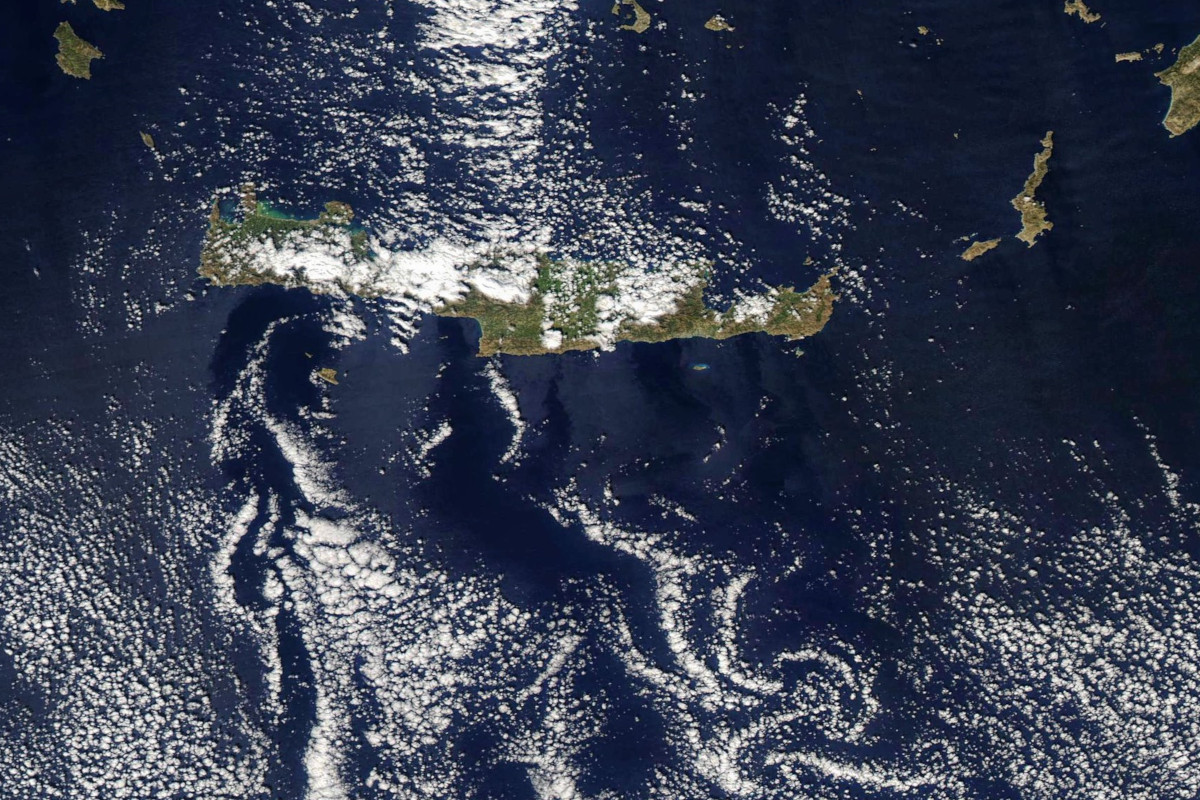 Crete seen from space. Image: Antti Lipponen, CC BY 2.0
Crete seen from space. Image: Antti Lipponen, CC BY 2.0
The flight campaign involving the Falco EVO drones produced by Leonardo-Finmeccanica commenced on 6 December 2018 from the airport on the island of Lampedusa. “Intelligence, Surveillance and Reconnaissance – ISR – missions are planned by the Guardia di Finanza with the Interior Ministry’s coordination,” the managers of the military-industrial holding company noted. “In this context, the support provided by ENAC, the national civil aviation authority, and ENAV, the company responsible for civilian air traffic in Italy, was decisive, as was that of AST Aeroservizi, the company that manages the airport in Lampedusa. The Falco EVO, equipped with an infra-red high-definition optical system, a satellite data connection Beyond the Line of Sight and an advanced suite of on-board sensors that includes the Gabbiano TS Ultra Light radar for long-range day and night time missions, operates with Leonardo’s flight personnel and maintenance teams.”[11]
The drone, authorised to fly over Italian and Maltese civilian airspace, has been used in two military operations in the Sicilian Channel to intercept vessels carrying migrants. The first mission was undertaken on 20 June 2019 against a fishing boat from which 75 migrants, including three women and three minors, were transferred onto smaller vessels that then disembarked in Lampedusa. The second mission, on the following 26 June, saw the Falco Evo operate for 17 hours, 21 minutes consecutively, supporting an intervention by the Italian armed forces against two vessels that were navigating in the waters near the Pelagic Islands.[12]
The EU miracle of the multiplication of drones
Thanks to the precious documentation work on relations between the EU and the Israeli military-industrial complex by the Coordination of pro-Palestinian Associations in Brussels, it has been possible to ascertain that the use of drones in the war against migrants and migrations at the EU’s external borders is far wider and more structured than it appears.
On 30 June 2020, in response to a parliamentary question by Miguel Urbàn Crespo MEP on drones leased from Elbit Systems (“a company accused of war crimes and human rights violations”[13]), the European Commission admitted that Lisbon-based company CeiiA had used Hermes 900 aircraft following the signature of a €59 million biannual contract with the EMSA.[14] The Hermes 900 started operating in June 2019 from the airport of Egilsstaðir in Iceland to monitor more than half of the Icelandic Exclusive Economic Zone (EEZ).[15] The managers of Elbit Systems explain that the drone for maritime patrolling and the related control land station had been purposely configured “to enable a constant monitoring of a vast maritime and coastal area and an effective identification of suspect activities and potential risks”.[16] Israeli aircraft were subsequently deployed in the Mediterranean.
“Two operations were operated by CeiiA: For the Icelandic Coast Guard during 119 days, from 24 April until 20 August 2019, when 62 flights performed over the sea at the Eastern part of Iceland, and [for] Frontex supporting the Hellenic Coast Guard with 34 operational days, from 2 December 2019 until 4 Jan 2020, performing 18 flights from Crete over the Ionian Sea”, the EU Commissioner for Industry and Research, Adina Ioana Valean, replied to a question by the MEP MIguel Urban Crespo of The Left group (formerly known as GUE/NGL) on 25 June 2020.
One of the Hermes 900 used by CeiiA crashed due to a technical fault on 8 January 2020 as it took off from the airstrip in Tympaki on Crete. Following this accident, surveillance and intelligence operations in Greek waters were reportedly suspended.[17] “The operation with CeiiA in Greece has been stopped,” Valean also stated. “Currently, the European Maritime Safety Agency is not carrying out any other maritime surveillance operations with this system, and nor are any other operations being prepared in this phase. The aircraft is undergoing tests after having been repaired and the investigation into the causes of the accident have not been completed yet”.[18] However, this did not prevent Elbit Systems and the Hermes 900 being chosen last October by Frontex to patrol the Mediterranean in the next two years.
The multi-purpose role of drones for control operations in the European context was confirmed on 19 September 2019 in a draft paper by the then Transport Commissioner, Violeta Bulc. “As part of European cooperation for the Coast Guard function, the European Maritime Safety Agency (EMSA), the European Fisheries Control Agency (EFCA) and the European Border and Coast Guard Agency (EBCG) have established joint information and maritime surveillance services, that include the use of remotely piloted aircraft”, Violeta Bulc wrote.
She continued:
“This has allowed to ensure an additional maritime surveillance capacity to national authorities to monitor sea pollution and the safety of navigation, identify vessels in distress, measure naval emissions, identify and track naval units involved in illegal activities, etc… EMSA, in agreement with EFCA and EBCG, has assumed a steering role for RPAS services, and it currently has eight contracts for the use of different remote piloted systems for different purposes. EMSA does not acquire the RPASs, but it underwrites contracts with the companies that operate in this sector.”
According to the former EU Commissioner, in 2018-19, EMSA coordinated drone operations in Portugal, Spain, Denmark, Greece, Croatia, Italy and Iceland.[19]
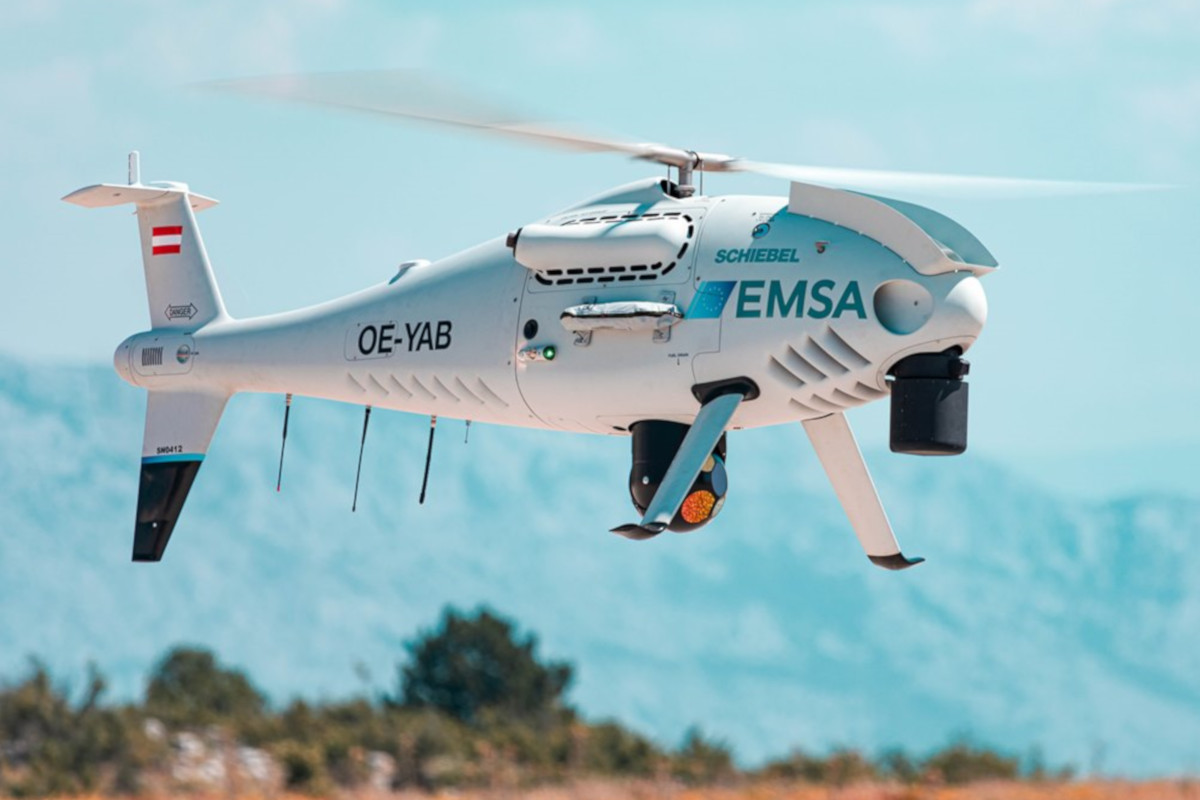
A Schiebel drone operated by the European Maritime Safety Agency (EMSA). Image: EMSA
By 10 October 2019, 10 contracts had been signed by EMSA to carry out RPAS operations, three of which are still ongoing and are for “general maritime surveillance”. The contracts are with the Portuguese company CeiiA (Elbit Systems Hermes 900 drones); the ‘React’ consortium, comprising Portuguese aerospace company Tekever and CLS, a company controlled by the French Space Agency (Tekever AR5 Evolution drone); and with the Austrian military electronics company Schiebel (UAV Campcopter S100). EMSA also already received eight formal requests to operate remotely piloted systems in 2020 from eight member states: Bulgaria, France, Germany, Italy, Lithuania, the Netherlands, Portugal and Spain.[20] Estonia, Finland and Romania have also recently joined the club, according to EMSA press releases.
The Falcon starts flying from Sicily again
In order to “extend” external maritime border surveillance 560 kilometres from the Sicilian coast and “prevent, counter and analyse the phenomenon of clandestine migration” in the central Mediterranean, the Italian Interior Ministry’s Central Directorate for Immigration and Border Police also decided to resort to unmanned aircraft. On 22 October 2020, the magazine Altraeconomia revealed that Italian public security authorities had hired a MALE drone produced by Leonardo at a cost of €8.8 million. The aircraft – which, once again, appears to be the Falco Evo tested with Frontex in Lampedusa in recent years – will be employed for a 12-month period that may be extended to 18 months, to undertake between 1,200 and 1,800 hours of flight.
“The Viminale [seat of the Interior Ministry] has acted for the purpose of increasing the capital of know-how within the National Coordination Centre of the European Border Surveillance System (NCC/EUROSUR) under the aegis of the Frontex agency,” Altreconomia reported. “As the ministry acknowledges, hiring a remotely piloted drone for a sum of €5,000 for an hour of flight is a noteworthy innovation. The tender, financed until June 2022 with resources from the 2014-2020 Internal Security Fund (ISF), reflects an obsession for control and surveillance following the substantive elimination of an institutional system for search and rescue at sea.”[21]
According to the tender’s technical specifications, the services provided by Leonardo will consist of undertaking airborne maritime surveillance missions, transmitting the information and data acquired to the National Coordination Centre “for its subsequent use and possible distribution to predetermined institutional referents,” and offering training courses to four pilots, two from the Polizia di Stato and two from the Guardia di Finanza, to control the drone from the land.
The package provided by Leonardo includes technical equipment (RPAS of a Medium Altitude Long Endurance type, land control station, sensors, etc.) and the necessary technical-logistical support. Daytime and night-time aero-maritime surveillance will take place “with at least 12 hours’ autonomy, without being visible or audible below 6,000 feet of altitude and capable of identifying objects measuring two metres at a distance of four kilometres.” The drone will operate from an airport that will be decided over the next few weeks by the Ministry, from those of Trapani-Birgi, Lampedusa or Ragusa-Comiso.
Specifically, the “surveillance of predefined areas in search for specific points” will be conducted, as will the “spotting, identification, tracking and monitoring of objects of interest”, “correlations between tracks”, “immediate provision to the tactical operator of the analysis content” and of the images and video collected by on-board sensors to the National Coordination Centre of the European Border Surveillance System. “The NCC/EUROSUR represents, in accordance with EU Regulation 1052/2013, the natural information exchange hub, also at an EU Restricted level [of security classification], between Member States and the Frontex Agency”, the Interior Ministry’s Public Security Department reports. “It is the designated place to receive all information relevant to the migration phenomenon, including those concerning search and rescue at sea operations that also have their source in trafficking and dealing in humans, for the purpose of coordinating the national border surveillance system”.[22]
The Predator’s claws
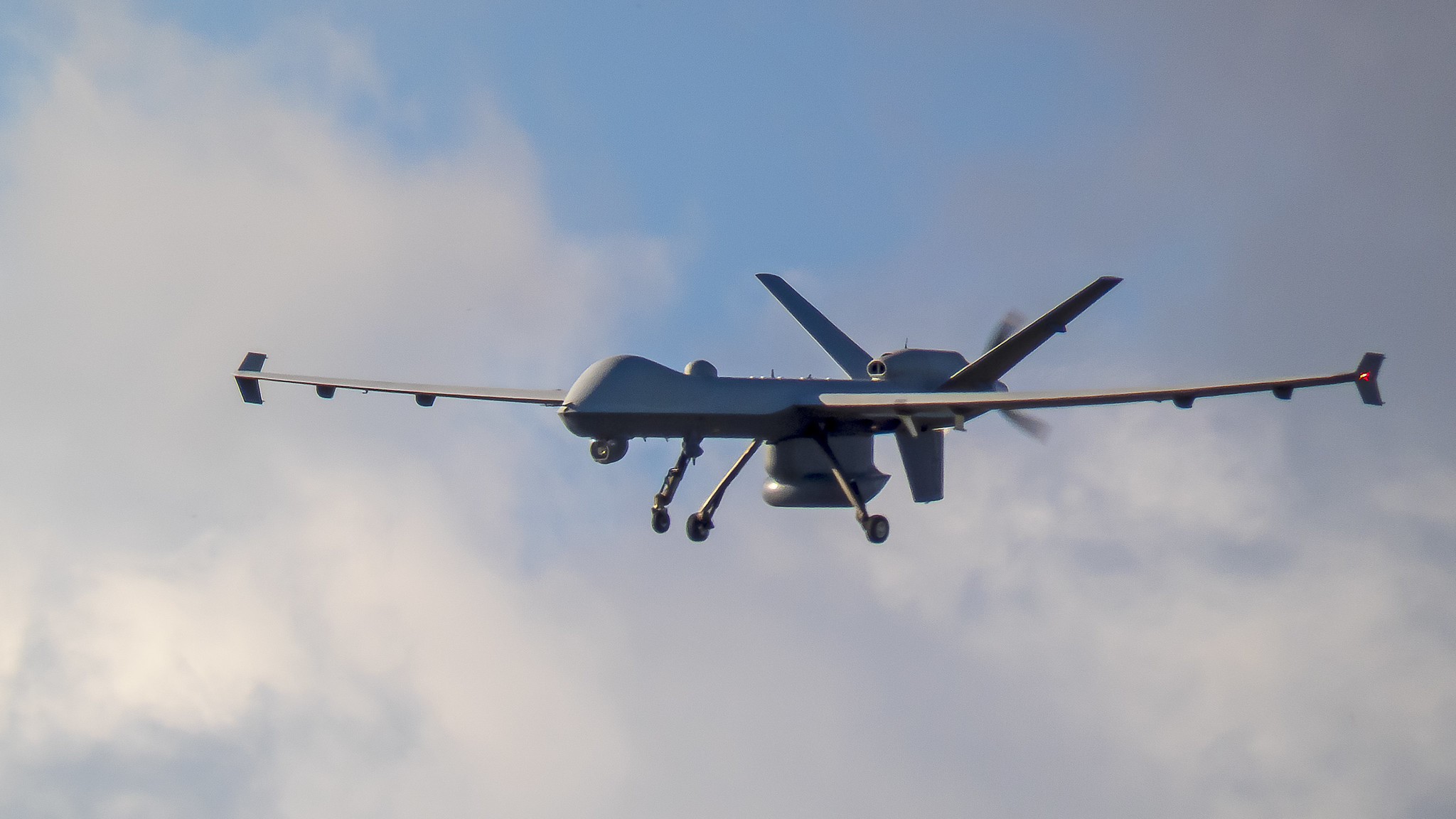 A Predator drone operated by US Customs Border Patrol. Image: Jonathan Cutrer, CC BY 2.0
A Predator drone operated by US Customs Border Patrol. Image: Jonathan Cutrer, CC BY 2.0
A contribution to the monitoring of the Mediterranean waters and the interception of vessels that carry migrants heading towards the southern Italian coasts has been provided since March 2014 by the Military Air Force that redeployed some remotely piloted RQ1 Predator aircraft from the airbase in Amendola (Foggia, in Apulia) to the large airbase in Sigonella. In order to manage the activities of these drones produced by the US giant General Atomics, on 10 July 2017 the 61st AMI Flight Group was activated in the Sicilian airbase. From an operative perspective, these aircraft interface with the aerial and naval units of national and NATO armed forces, and with those assigned to the EU military missions in the Mediterranean (currently, EUNAVFOR Operation Irini, formerly Sophia), as well as with NATO’s AGS (Alliance Ground Surveillance) intelligence and terrestrial surveillance drones. The NATO command established in Naval Air Station Sigonella has repeatedly expressed its availability to deploy the AGS system against illegal immigration and trafficking in human beings.
It should be noted that on 20 November 2019 an Italian Air Force Predator crashed in Libyan territory. The accident caused a degree of embarrassment among political and military authorities; as the analyst Gianandrea Gaiani remarked, “Italy did not explain what a remotely piloted aircraft MQ9 Reaper (Predator B) was doing when it was taken down in flight by a missile of the Libyan National Army [LNA], Haftar’s forces, not far away from Tarhouna, a city that is around 60 kilometres south of Tripoli that is a stronghold of the LNA.”[23]
The short statement issued by the Ministry of Defence after the Predator was shot down did not contribute to clarifying the real reasons for the intelligence mission. “Today - the press statement says – we have lost contact with a remotely piloted aircraft of the Aeronautica Militare [the Italian Air Force], which subsequently crashed in Libyan territory. The aircraft that was undertaking a mission in support of the Mare Sicuro operation, was following a flight plan that had been pre-emptively communicated to the Libyan authorities.”[24] By omitting any reference to the type of drone that was used and to the causes of the incident, the Defence Ministry justified its use in an operation (Mare Sicuro) whose geographical reach, however, is limited to the central Mediterranean and Libyan territorial waters to “support and bolster the Libyan Coast Guard and Navy to counter unlawful maritime trafficking.”[25]
Frontex also views the possibility of deploying Predator drones in ‘defence’ of the European Union’s external borders. As of December 2019, General Atomics technicians commenced a series of test flights using a new version of the MQ-9, purposely preconfigured to undertake maritime surveillance operations from the Greek airbase of Larissa in collaboration with the Greek Air Force.[26] The new drone, called SeaGuardian, was equipped with a sophisticated radar and a data reception system from large-sized naval units to satisfy one of Frontex’s most pressing demands to control the Mediterranean.[27]
The time of anti-immigrant balloons comes
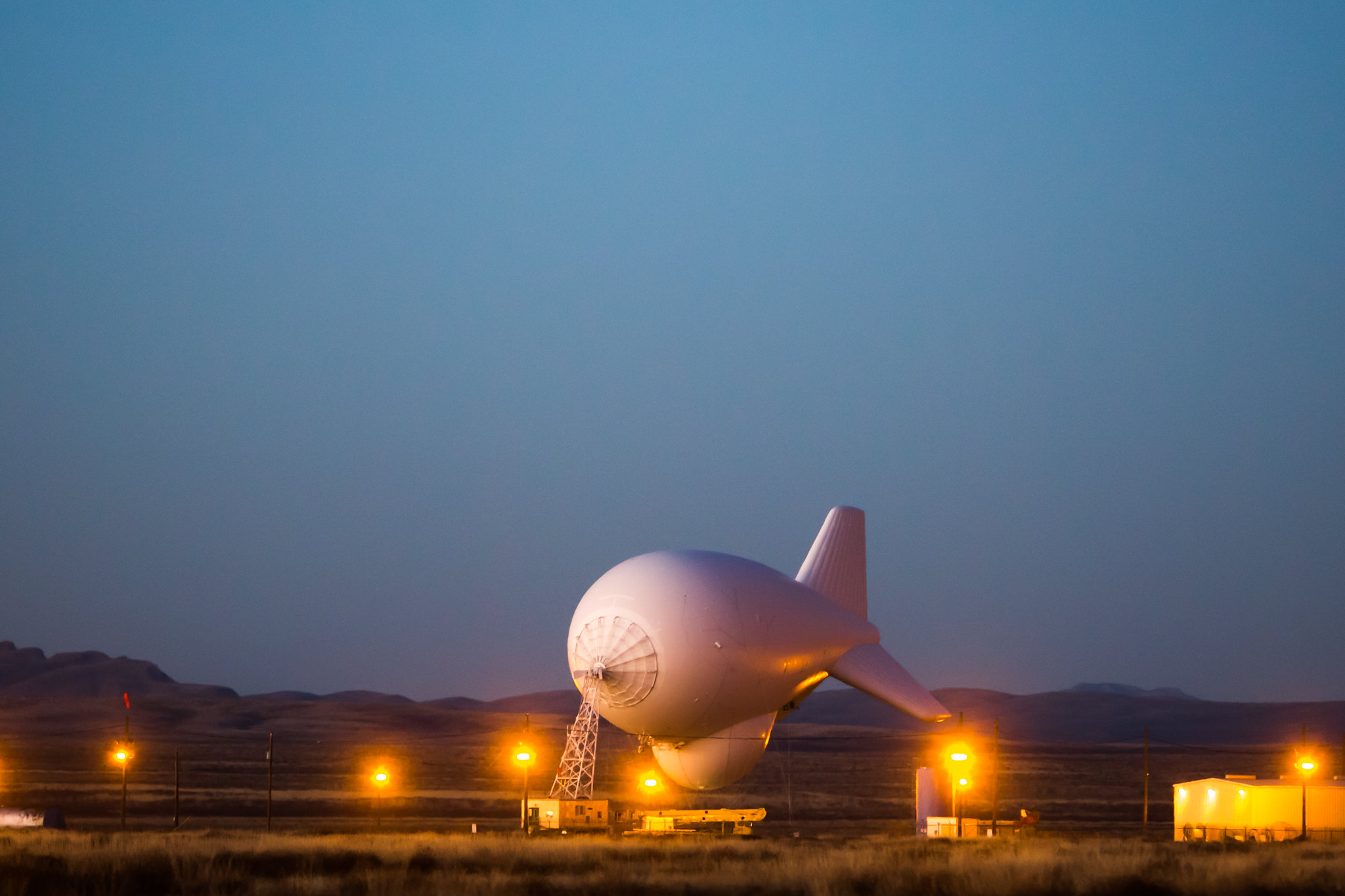 A tethered aerostat being launched. Image: Thomas Hawk, CC BY-NC 2.0
A tethered aerostat being launched. Image: Thomas Hawk, CC BY-NC 2.0
To strengthen the automation and dehumanisation that are features of the current war against migrants and migration, Frontex also aims to use airships. After a series of tests undertaken from Samos island in the eastern Aegean in collaboration with the Greek Coast Guard, Frontex decided to launch a pilot project by the end of 2021 to evaluate the efficiency and costs of aerostat platforms for border controls and to “modify and optimise the equipment that has already been tested.”[28] Thus, a call for tenders was issued to “hire two aerostats for maritime and environmental surveillance, with a view to a second pilot project supported by the host country, Greece”. The contract is worth just over €3 million for a duration of twelve months, including the technical personnel required to execute tests.[29]
During the trials undertaken in Samos, the aerostat used by Frontex and the Greek Coast Guard was the Tethered Aerostat Radar System (TARS) produced in the US by the Lockheed Martin group and the advanced engineering company ILC Dover, which is already used by the US Customs Service against illegal drug trafficking.[30] Equipped with a radar whose reach covers 200 nautical miles, a thermal camera and an Automatic Identification System, the TARS is 35 metres long, can fly to heights of up to 4,600 altitude and can carry a load of 1,200 kilograms. The remote identification systems that are customarily installed on board are the EL/M-2083 of the Israeli Elta Systems and the JLENS of the US company Raytheon. The first one is based on the radar used by the Israeli armed forces for its anti-ballistic missile system with an Arrow land base, capable of “a swift deployment for active electronic control and the long-distance identification of enemy aircraft, especially when they operate at low altitude”, as its manufacturing company Israel Aerospace Industries explains. The JLENS (Joint Land Attack Cruise Missile Defense Elevated Netted Sensor System), AKA the “spy balloon”, was designed to intercept and track vessels, land vehicles, cruise missiles, aircraft with and without pilots, etc. Hence, it is unequivocable that also the aerostats are veritable death systems which, after having been deployed in war theatres, are now ‘converted’ into key instruments for the control of borders against “incursions” by migrants and asylum seekers.
Seeking researchers to hypermilitarise borders
In the meantime, the Frontex agency has decided to make its own “experts” available to the European Commission’s General Directorate for Migrations and Internal Affairs in support of its research, testing, and development of innovative technologies for the control of land and sea borders. In particular, Frontex is contributing to implementation of relevant parts of the multi-annual EU investment programmes into research, Horizon 2020 (2014-2020) and Horizon Europe (2021-2027).
The final three-year tranche of Horizon for the so-called plan for societal security devoted €118 million to finance research into “Border and External Security”. In this field, Frontex “will identify research activities aimed at reducing gaps and vulnerabilities in the surveillance and situational awareness sectors; of biometrics, cybersecurity and the availability and exchange of information; to contribute to developing solutions that may facilitate its operative tests within Frontex Joint Operations [JOs] and in close cooperation with national authorities; to monitor the results of the searches to support their operative relevance and facilitate their absorption into the market.”[31]
A wide spectrum of technological instruments feature in the Horizon programmes sponsored by Frontex for the purpose of border security: firstly, remotely piloted platforms, whether they are airborne, land-based or naval; equipment to gather biometric data and those for three-dimensional face and iris scanning; command, control and intelligence systems; artificial intelligence (AI); robotics; integrated systems to identify trafficking in drugs etc..[32] In a press statement on 11 August 2020, Frontex also publicised the “projects of interest” financed using Horison 2020 research and development funds. These programmes are called ANDROMEDA, ARESIBO, BorderSens, COMPASS2020, D4Fly, MIRROR and PERCEPTIONS.[33]
The ANDROMEDA project (acronym of An EnhaNceD Common InfoRmatiOn Sharing EnvironMent for BordEr CommanD, Control and CoordinAtion Systems) seeks to establish a command system to oversee the EU’s maritime border control activities and to promote information exchange between naval forces, coast guard authorities and the police forces of member states and third countries. Financed with €5 million, ANDROMEDA is undertaken by the Israeli Public Security Ministry; the ministries of defence of Italy, Greece and Portugal; several universities; important research centres in the cybersecurity sector; and some of the leading European military aerospace industries (Leonardo-Finmeccanica, Thales Alenia Space Italia, Avio S.p.A., Piaggio Aereo Industries, GMV Aerospace and Defence SA), with the collaboration of the Common Information Sharing Environment (CISE), the EU agencies and institutions EMSA, Frontex, EEAS (European External Action Service), EDA (European Defence Agency) and the European Union Satellite Centre (EUSC). ANDROMED commenced on 1 September 2019 and was due to end on 28 February 2021.[34]
Financed by the European Union with €7 million ARESIBO (Augmented Reality Enriched Situation awareness for Border security) commenced on 1 May 2019 and should end on 30 April 2022. The project is coordinated by the French aerospace giant Airbus Defence and Space SAS, and features the involvement of 19 partners, including IES Solutions – Intelligence for Environment and Security S.r.l. (an advanced technological research company based in Rome and Catania); the German IT group Ubimax GMBH; the Greek and Portuguese Defence Ministries; the NATO Science and Technology Organization (the NATO body for scientific-technological research in the military field); ISIG – Istituto di Sociologia Internazionale di Gorizia (Gorizia International Sociological Institute); and the Protection and Guard Service of the Romanian Ministry of Defence.[35]
The purpose of ARESIBO is to create an “innovative” analysis system on “potential threats” and for patrolling and surveillance to respond to “emergencies” and partake in “search and rescue” activities and other operations planned at the European level. “This system will make it possible to acquire a more accurate picture of the situation, filtering an enormous amount of information collected from multiple sources”, the project’s proponents write. “Aresibo takes into consideration the use of all the types of remotely piloted systems that are able to respond to the operative requests of the land and sea border security missions. It also optimises the functions of platforms dedicated to surveillance with a view to their integration into existing processing systems to interpret, merge and correlate a great quantity of data”.
BorderSens, meanwhile, will create a European system to locate illegal drugs (with EU funding worth just over €5.5 million, lasting from 1 September 2019 to 31 August 2023). The COMPASS2020 (Coordination Of Maritime assets for Persistent And Systematic Surveillance) project aims to tackle “the challenges represented by irregular immigration and drug trafficking” with the goal of experimenting “the combined use and perfect coordination between piloted assets and those without pilots to achieve a greater coverage, an improved quality of information and shorter response times during maritime surveillance activities”.
The solution proposed by COMPASS2020 is the contextual use of drone aircraft and automated sub-water units (UxVs) to be deployed on board of naval units and/or in land bases. The platforms will be supported by a central control and command system and they will carry out “persistent and long-range” surveillance operations, strengthening the functions of the coast guard authorities and national maritime authorities. The project also envisages the development of new software to heighten the analysis capabilities concerning data collected by remotely controlled aircraft. COMPASS2020 began on 1 May 2019 and will end on 30 April 2021. Financed by “Horizon” to the tune of €6 million, it is being implemented by 14 partners, including the Portuguese General Maritime Directorate (coordinating body); the French shipbuilding company Naval Group; the German aerospace group Airbus Defence and Space GMBH; Eca Robotics (French robotics engineering company); the UK Home Office and, once again, the NATO Science and Technology Organization.[36]
The fifth research project at the EU level supported by Frontex is D4Fly (Detecting Document frauD and iDentity on the fly) which aims to improve the quality and effectiveness of identification processes at all land, air and sea border posts by providing more secure control instruments. Among the latter, the proponents of D4Fly list biometric technologies for three-dimensional face, iris and somatic feature checks; Apps for smartphones to check travellers’ thermal and multi-spectral images “to counter manipulations and detect the morphed facial images of impostors”; and new IT programmes to verify possible falsification of identity documents and passports.
D4Fly commenced on 1 September 2019 and will end on 31 August 2022. The project is coordinated by Veridos GMBH, a leading worldwide company for the organisation of security controls whose headquarters are in Berlin and which has subsidiaries in the US, Canada, Mexico, Greece, Singapore and the United Arab Emirates. Its eighteen partners include the Dutch Ministry of Defence and Ministry of Justice; the Piraeus Port Authority (Greece); and the Lithuanian National Border Protection Service. The EU has financed the project with €7 million .[37]
The strategic objective of MIRROR (Migration-Related Risks caused by misconceptions of Opportunities and Requirement) is to develop an integrated platform, a series of instruments and a “systematic methodology” to enable “a comprehensive analysis on the perception of Europe and to identify discrepancies between what is perceived in Europe itself and what is real, including creation of an awareness of the impact deriving from it and of threats that are generated, including hybrid threats”. For this purpose, the project will analyse written texts and messages transmitted by multi-media networks, social networks and other communication channels, using new technological instruments and artificial intelligence.
The research project’s leading proponent is the Gottfried Wilhelm Leibniz University in Hannover (Germany): among the thirteen partners, there are the German Defence Ministry; the Maltese and Swedish police forces; the state universities of Vienna and Malta; the Italian Eurix (IT consultancy company based in Turin), Conoscenza e Innovazione (a sociological and interdisciplinary research centre based in Rome) and the Fondazione Agenfor International, a “non-profit network” on security based in Milan with subsidiaries in Padua, Lugano (Switzerland), Tripoli (Libya) and al-Qamashly (Syria).[38] €5.18 million has been provided by the European Commission.
A similar sociological-security study programme is called PERCEPTIONS (Understand the Impact of Novel Technologies, Social Media, and Perceptions in Countries Abroad on Migration Flows and the Security of the EU & Provide Validated Counter Approaches, Tools and Practices), provided with almost €5 million.
This programme seeks to identify the narratives, images and perceptions about Europe that people have abroad, and to investigate how these may lead to “problems” like false expectations, threats for security or even radicalisation. “But most of all, the aim is to design toolkits of creative and innovative measures to react to and counter this type of problems by taking social and structural aspects into account”, the research’s proponents explain. “Current theories on migrations focus on push and pull factors. Economic, social and political factors are certainly central elements that push people to migrate. It is just as important to consider how the places of arrival are imagined in a desirable and attractive way, especially is there are false narratives that may influence decisions about migration. This project will help to identify the wrong ideas about the European Union that people have abroad and how much they are contributed to by myths circulated in social media and by new communication networks, in order to develop policy recommendations and plans of action at the EU level”. PERCEPTION envisages creating a Web platform aimed at groups and individuals that are “sensitive” to migration processes, in order to provide “relevant and easily accessible information” to “deconstruct false narratives and enhance the dissemination of real news”, thus reducing their possible impacts on EU border controls.
This project, which started on 1 September 2019 and will end on 31 August 2022, features the participation of the Israeli, Greek and Bulgarian police forces; several universities (including the Alma Mater Studiorum of Bologna and La Sapienza in Roma); research centres on migration and security policies; non-governmental organisations like, for example, Caritas in Nicosia (Cyprus) and France’s Association des Agences de la Democratie Locale, an international association “dedicated to the promotion of human rights, good government and citizens’ participation at the local level.” The long list of proponents of this controversial programme on the “perceptions of migrants” also includes the Fondazione Bruno Kessler of Trento, a research body of the autonomous province that works in the scientific-technological field and that of human sciences, paying special attention to artificial intelligence, IT and nuclear physics.[39]
The long Libyan hand of Fortress Europe
The most troubling aspect of this relentless process of information gathering on migration flows thanks to new automated technologies, however, is the offer and transfer of intelligence by Frontex and other EU and national agencies to the military and police forces of third countries, mainly on the southern Mediterranean shore. These are conducts that have undergone a swift acceleration in the last three/four years and which largely correspond to the strategy of Brussels and Warsaw to “share” their policies for the military containment of migrations and to externalise actions and interventions that flagrantly violate international law, fundamental freedoms and the human rights of migrants, refugees and asylum seekers outside of the EU.
The modalities and consequences of the unlawful “transfer” of intelligence to non-EU countries were analysed in a previous analysis published by Statewatch. Images collected by EMSA drones are immediately evaluated by the coast guard authorities of the territorially competent nations, and they are contextually sent to the Frontex headquarters and integrated into the Border Surveillance System (EUROSUR) to be analysed by the European agency and by the control network of all the EU member states with external borders.
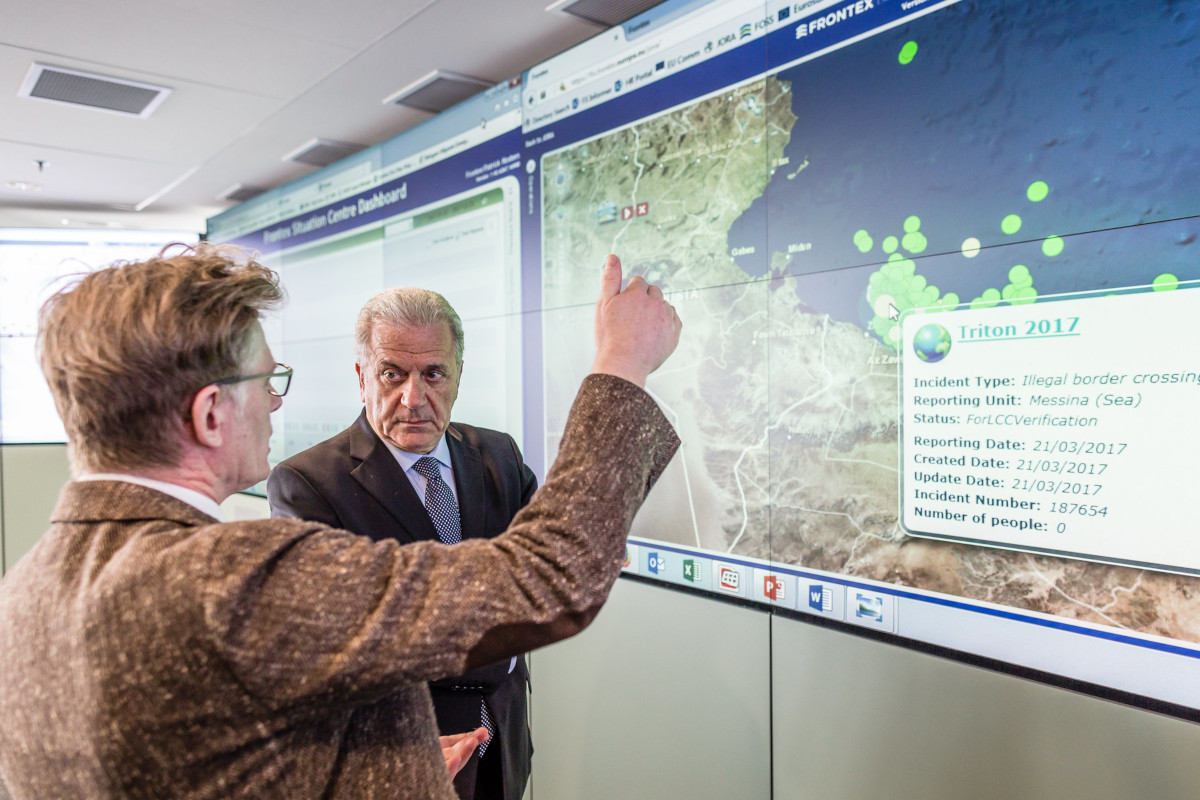 Former EU Commissioner for Migration and Home Affairs, Dimitris Avramopoulos, visits the Frontex headquarters in Warsaw, 2017. Image: Dimitris Avramopoulos, CC BY-SA 2.0
Former EU Commissioner for Migration and Home Affairs, Dimitris Avramopoulos, visits the Frontex headquarters in Warsaw, 2017. Image: Dimitris Avramopoulos, CC BY-SA 2.0
“Surveillance data is used to detect and prevent migration movements at an early stage”, the article noted. “Once the providing company has been selected, the new Frontex drones are also to fly for EUROSUR”, within whose framework “Frontex shares the recorded data with other European users via a ‘Remote Information Portal’.” Furthermore: “The data from EUROSUR and the national border control centres form the ‘Common Pre-frontier Intelligence Picture’,” thus extending “the area of interest of Frontex… far into the African continent”. The contracts underwritten with companies that provide remotely piloted aircraft foresee operations in the waters of the central and eastern Mediterranean within a radius of around 463 kilometres (250 nautical miles) from their departure bases.
“This would enable them to carry out reconnaissance in the ‘pre-frontier’ area off Tunisia, Libya and Egypt,” the analysis notes. The new Frontex Regulation provides that, “in order to share general information on surveillance of the Mediterranean Sea with a non-EU state, Frontex must first conclude a working agreement with the corresponding government”. However, there is evidence that the “EU military mission ‘EUNAVFOR MED’ was cooperating more extensively with the Libyan coast guard (…) Libya is the first third country to be connected to European surveillance systems via the ‘Seahorse Mediterranean’ network. Information handed over to the Libyan authorities might also include information that was collected with the Italian military ‘Predator’ drones.”[40]
The Seahorse Mediterranean Network is a cooperation programme to “improve information exchange in the Mediterranean area” signed by seven Member States (Spain, Italy, France, Malta, Cyprus and Portugal) and by north African countries, within the EUROSUR framework. It also envisages a series of training and formation initiatives aimed at African operators in the field of maritime surveillance. In partnership with the Spanish Guardia Civil, the Italian Guardia di Finanza (GdF) organised and provided a training course in Gaeta (Latina) on “driving naval units” for the personnel of the Libyan Coast Guard and Ministries of Defence and for Interior Affairs (the EU’s contribution to the GdF was €475,000).[41]
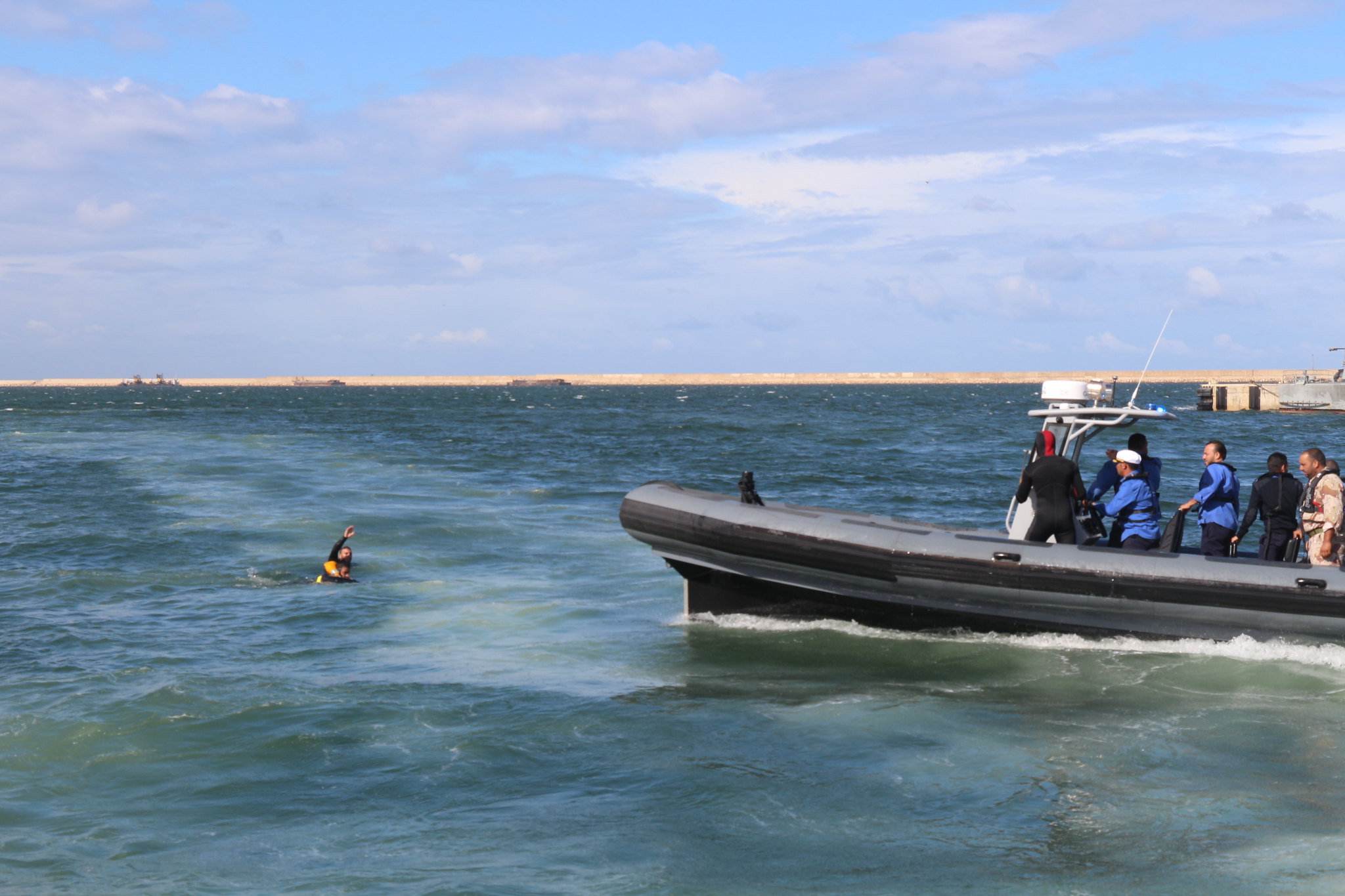 The Libyan Coast Guard receives training from the EU's Border Assistance Mission. Image: European External Action Service, CC BY-NC-ND 2.0
The Libyan Coast Guard receives training from the EU's Border Assistance Mission. Image: European External Action Service, CC BY-NC-ND 2.0
Libya’s direct involvement in EU operations to stop and return migrant vessels to their place of departure was “legitimated” in June 2018 by Italy’s reckless and irresponsible decision to entrust to it the undertaking of interventions to search, rescue and save shipwreck victims in the Libyan SAR (Search and Rescue) Maritime Region. The identification and establishment of this SAR zone were assigned in 2016 by the European Commission to the Maritime Rescue Coordination Centre in Rome (IMRCC).
The exchange of competences between Rome and Tripoli turned this SAR region into an immense Libyan hunting ground to target vessels heading for southern Italy or Malta, with people on board seeking humanitarian protection and asylum in an EU that is always less welcoming.[42] The United Nations Convention on the Law of the Sea provides that any information about a real or suspected emergency involving a naval vessel must be sent to the nearest Maritime Rescue Coordination Centre (MRCC). Thus, despite a chronic lack of means and personnel and the questionable will of the Libyans to provide maritime assistance and rescue services, it happens that when remotely piloted Frontex aircraft identify vessels in distress, this information is relayed to Tripoli, as the party “responsible” for search activities in its own SAR zone, through its own MRCC. This allows Frontex not to intervene to rescue migrants in distress identified by its own drones and to cynically leave the (possible) responsibility for intervening to Libya.[43]
“The legal obligation to aid a vessel in distress does not apply to an unmanned aerial vehicle”, Phil McDuff explains in The Guardian. “You can avoid the politically fraught argument about who should take care of rescued migrants if you never rescue them in the first place (…) If we are obliged to rescue those who ask us for help, the solution seems to be to ensure we cannot hear their request”.[44]
Obviously, the European Commission rejected any allegations on this point. On 8 January 2020, Josep Borrell, the EU High Representative for Foreign Affairs and Security Policy, answered a parliamentary question by denying that Frontex has ever provided information to the Libyan Coast Guard within the framework of surveillance operations undertaken by Member States at their external borders in cooperation with the agency.[45] “However, this has occurred within the framework of the Eurosur Fusion Service — Multipurpose Aerial Surveillance (MAS)”, Commissioner Borrell admitted. “During MAS aerial surveillance in the pre-frontier area – from 2017 to 20 November 2019 – when Frontex identified distress situations in the Libyan SAR zone, on 42 occasions the agency informed the MRCC of the nearest member state and EUNavFOR MED, as well as the Libyan Coast Guard.”[46]
Brussels has also had to admit that it is aware of Tripoli’s considerable organisational limits for maritime search and rescue and regarding the technical-organisational effectiveness of the centre that is meant to oversee SAR operations by the Libyan Coast Guard. On this point, it is worth reporting what was stated on 20 May 2019 by the EU Finance Commissioner, Johannes Hahn. After noting that in June 2017 the Italian Coast Guard received European funding worth €1.8 million to prepare a feasibility study to advise its Libyan counterpart in the legal and technical field for SAR activities (Operation Aurora), Commissioner Hahn clarified that the study was presented in Brussels in January 2019 with a request to provide Libya with systems of control, command, telecommunications and maritime traffic monitoring, satellite radio equipment, as well as the training required. The Commission subsequently authorised the purchase of what Italy asked through a programme called ‘Support to Integrated Border and Migration Management in Libya, first phase’ (worth €46 million), adopted within the framework of the Emergency Trust Fund for Africa.[47]
“Establishing the Maritime Rescue and Coordination Centre (MRCC) is part of the second phase of the programme (€45 million disbursed in December 2018),” Hahn specified. “Negotiations between the Commission and the Italian interior ministry to create this MRCC are underway. Procedures leading to a call for tenders to purchase the MRCC’s main equipment and systems will be issued during 2019 and 2020.”[48] Hence, this will be around one-and-a-half or two years after the Italian/Libyan transfer of “control” over an extensive and very heavily navigated SAR region in the central Mediterranean.
A dark epilogue
In the meantime, there have been a proliferation of allegations concerning unlawful “pushbacks” to North Africa of migrant vessels that seek to cross the Sicilian Channel, thanks to a tight partnership between Frontex and Tripoli’s Navy. On 17 June 2020, four non-governmental organisations (Alarm Phone, Borderline-Europe, Mediterranea Saving Humans and Sea-Watch) presented their report Remote control: the EU-Libya collaboration in mass interceptions of migrants in the Central Mediterranean, which highlights how the actions undertaken by the EU in collaboration with the Libyan authorities are facilitating mass migrant interceptions and returns. In particular, the report reconstructs some search and rescue events that ended up with interceptions and returns to Libya.[49]
“EU aerial assets are deployed to detect migrant boats from the air and guide the so-called Libyan Coast Guard”, the NGOs write. “Aerial surveillance has led to the capture of tens of thousands of people and their return to the Libyan war zone” in operations that are straightforward violations of fundamental rights. “EU actors have delegated responsibility to the Libyan authorities and become complicit in the systematic interception and return of people seeking to escape from Libya.” The cases documented in the report show “the crucial role played by EU aerial surveillance in mass interceptions off the coast of Libya, which have been expanded over recent months”.[50]
The report’s authors conclude that “EU aircraft identify migrant vessels and only contact Libyan authorities, de facto preventing other ships from intervening and disembarking rescued people in a safe port”. Finally, “EU authorities have further instrumentalized the COVID-19 crisis to normalise already existing practices of non-assistance at sea and continue to violate the non-refoulement principle at sea. Under no circumstances can the COVID-19 pandemic justify the push- and pull-back of fleeing migrants to Libya.”[51]
Antonio Mazzeo
Notes
Editor's note: this article was corrected on 10 May 2021. A parliamentary question asked by Miguel Urban Crespo MEP was attributed to Özlem Demirel MEP.
[1] J. Jolly , “Airbus to operate drones searching for migrants crossing the Mediterranean”, The Guardian, 20.10.2020, https://www.theguardian.com/business/2020/oct/20/airbus-to-operate-drones-searching-for-migrants-crossing-the-mediterranean
[2] S. Chemla, “Israeli Aerospace Industries’ Heron UAV to fly for EU”, The Jerusalem Post, 22.10.2020, https://www.jpost.com/israel-news/israeli-aerospace-industries-heron-uav-will-fly-for-the-european-union-646540
[3] 2020/S 196-473315
[4] Human Rights Watch, Precisely Wrong. Gaza Civilians Killed by Israeli Drone Launched Missiles, New York, June 2009, https://www.hrw.org/sites/default/files/reports/iopt0609webwcover_0.pdf
[5] A. Giansiracusa, “In Afghanistan perso un Heron tedesco”, 21.11.2020, https://www.aresdifesa.it/2020/11/21/in-afghanistan-perso-un-heron-tedesco/
[6] https://ted.europa.eu/udl?uri=TED:NOTICE:473315-2020:TEXT:EN:HTML
[7] “Frontex si rivolge ad Airbus per la sorveglianza aerea marittima con UAS”, Analisi Difesa, 21.10.2020, https://www.analisidifesa.it/2020/10/frontex-si-rivolge-ad-airbus-per-la-sorveglianza-aerea-marittima-con-uas/
[8] Palestinian Grassroots Anti-apartheid Wall Campaign (Stop The Wall) – European Coordination of Committees and Associations for Palestine (ECCP), Stop Israeli Killer Drones, February 2020, https://www.stopthewall.org/sites/default/files/StopIsraeliKillerDrones_0.pdf
[9] https://ted.europa.eu/udl?uri=TED:NOTICE:10629-2018:TEXT:EN:HTML
[10] Frontex. “Frontex begins testing unmanned aircraft for border surveillance”, 27.9.2018, News Release, https://frontex.europa.eu/media-centre/news-release/frontex-begins-testing-unmanned-aircraft-for-border-surveillancezSQ26A
[11] Ufficio Stampa di Leonardo S.p.A., “Al via i voli del drone Falco EVO per missioni di sorveglianza marittima nell’ambito del programma di test di Frontex”, Rome, 6.12.2018, https://www.leonardocompany.com/it/press-release-detail/-/detail/falco-drone-frontex-sensori-guardia-finanza
[12] https://www.tgcom24.mediaset.it/mondo/mediterraneo-il-trucco-della-nave-madre-ecco-come-funziona-la-tratta-dei-migranti-vicino-a-lampedusa_3215907-201902a.shtml
[13] https://www.europarl.europa.eu/doceo/document/E-9-2020-001178_EN.html
[14] https://ted.europa.eu/udl?uri=TED:NOTICE:116450-2018:TEXT:EN:HTML
[15] “Elbit Systems Commenced the Operation of the Maritime UAS Patrol Service to European Union Countries”, New Press, 18.6.2019, https://elbitsystems.com/pr-new/elbit-systems-commenced-the-operation-of-the-maritime-uas-patrol-service-to-european-union-countries/
[16] “Elbit Systems Selected to Provide Maritime UAS to the European Union Maritime Safety Agency”, 1.11.2018, http://www.defense-unmanned.com/article/3271/elbit-wins-to-provide-maritime-uas-to-european-union-maritime-safety-agency.html
[17] M. Monroy, “Against Migration: EU drone crashed in Crete”, https://digit.site36.net/2020/01/31/against-migration-eu-drone-crashed-in-crete/
[18] https://www.europarl.europa.eu/doceo/document/E-9-2020-000567-ASW_EN.html
[19] https://www.europarl.europa.eu/doceo/document/E-9-2019-002454-ASW_EN.pdf
[20] M. Monroy, “North and Baltic Sea: German authority orders EU drone surveillance”, https://digit.site36.net/2020/06/01/north-and-baltic-sea-german-authority-orders-eu-drone-surveillance/
[21] D. Facchini, “Un drone per sorvegliare il Mediterraneo e fermare i migranti. Il nuovo appalto del ministero dell’Interno”, Altraeconomia, 22 October 2020
[22] Ministero dell’Interno – Dipartimento di Pubblica Sicurezza, Gara Europea per la fornitura di un pacchetto completo consistente nel servizio di noleggio di un sistema aeromobile a pilotaggio remoto (S.A.P.R.), comprensivo di correlati servizi di supporto tecnico logistici e addestrativi . Capitolato tecnico, Rome, 2020
[23] G. Gaiani, “L’imbarazzante caso dei droni italiano e americano abbattuti in Libia”, Analisi Difesa, https://www.analisidifesa.it/2019/11/limbarazzante-caso-dei-droni-italiano-e-americano-abbattuti-in-libia/
[24] Ministero della Difesa, “Difesa: precipitato velivolo a pilotaggio remoto”, Rome, 20.11.2019, https://www.difesa.it/SMD_/Comunicati/Pagine/Difesa_precipitato_velivolo_pilotaggio_remoto.aspx
[25] Ministero della Difesa, “Operazione Mare Sicuro”, Roma, https://www.difesa.it/OperazioniMilitari/NazionaliInCorso/MareSicuro/Pagine/default.aspx
[26] General Atomics Aeronautical, “European Maritime Flight Demonstrations”, http://www.ga-asi.com/european-maritime-demo/
[27] Statewatch, “Drones for Frontex: unmanned migration control at Europe’s borders”, 27 February 2020, https://www.statewatch.org/analyses/2020/drones-for-frontex-unmanned-migration-control-at-europe-s-borders/
[28] Frontex Media Centre,“Frontex to launch maritime surveillance by aerostat pilot project”, News Release, 11 September 2020, https://frontex.europa.eu/media-centre/news-release/frontex-to-launch-maritime-surveillance-by-aerostat-pilot-project-KzMGfe
[29] https://etendering.ted.europa.eu/cft/cft-display.html?cftId=7148
[30] Frontex to Launch Pilot Project for Maritime Surveillance by Aerostat, 15 September 2020, https://www.schengenvisainfo.com/news/frontex-to-launch-pilot-project-for-maritime-surveillance-by-aerostat/
[31] Frontex, Frontex to provide border security expertise to European Commission’s research projects, 6 February 2020, https://frontex.europa.eu/media-centre/news-release/frontex-to-provide-border-security-expertise-to-european-commission-s-research-projects-ZrCBoM
[32] https://frontex.europa.eu/research/eu-research/introduction/
[33] Frontex, Frontex helping to bring innovation to future border control, News Release, 11 August 2020, https://frontex.europa.eu/media-centre/news-release/frontex-helping-to-bring-innovation-to-future-border-control-VetIX5
[34] A. Mazzeo, “Frontex a caccia di migranti grazie ad Israele e al complesso militare-industriale UE”, 17.9.2020, http://antoniomazzeoblog.blogspot.com/2020/09/frontex-caccia-di-migranti-grazie-ad.html
[35] https://cordis.europa.eu/project/id/833805
[36] https://cordis.europa.eu/project/id/833650
[37] https://cordis.europa.eu/project/id/833704
[38] https://cordis.europa.eu/project/id/832921
[39] A. Mazzeo, “Frontex, Polizia d’Israele e Università europee contro le migrazioni mediterranee”, 22.9.2020, http://antoniomazzeoblog.blogspot.com/2020/09/frontex-polizia-disraele-e-universita.html
[40] Matthias Monroy, ‘Drones for Frontex: unmanned migration control at Europe’s borders’, Statewatch, 27 February 2020, https://www.statewatch.org/analyses/2020/drones-for-frontex-unmanned-migration-control-at-europe-s-borders/
[41] http://www.gdf.gov.it/documenti-e-pubblicazioni/altri-contenuti/sviluppo-progetti-e-finanziamenti-progetti-del-corpo-finanziati-con-risorse-comunitarie/seahorse-mediterranean-network
[42] A. Mazzeo, “Le guerre per procura contro i migranti e le migrazioni di Roma, UE e NATO”, 2018, https://www.academia.edu/40797974/Le_guerre_per_procura_contro_i_migranti_e_le_migrazioni_di_Roma_UE_e_NATO
[43] M. Monroy, “Frontex Aerial Service: Reconnaissance for the so-called Libyan coast guard”, https://digit.site36.net/2020/06/26/frontex-air-service-reconnaissance-for-the-so-called-libyan-coast-guard/
[44] P. McDuff,“L’uso dei droni per guardare i migranti che affogano mette a nudo tutta la disumanità delle pratiche di controllo sui confini”, The Guardian, 6.8.2019, https://www.meltingpot.org/L-uso-dei-droni-per-guardare-i-migranti-che-affogano-mette.html
[45] Regulation (EU) 656/2014 on the surveillance of the external sea borders,
[46] https://www.europarl.europa.eu/doceo/document/E-9-2019-002654-ASW_EN.html
[47] https://ec.europa.eu/trustfundforafrica/region/north-africa/libya/support-integrated-border-and-migration-management-libya-first-phase_en
[48] https://www.europarl.europa.eu/doceo/document/E-8-2019-000190-ASW_EN.html
[49] S. Sanderson, “EU accused of using aerial surveillance to help push migrants back to Libya”, 19.6.2020, https://www.infomigrants.net/en/post/25494/eu-accused-of-using-aerial-surveillance-to-help-push-migrants-back-to-libya
[50] https://www.borderline-europe.de/sites/default/files/readingtips/RemoteControl_Report_0620.pdf
[51] “New Report: Aerial collaboration between the EU and Libya facilitates mass interceptions of migrants”, Press Release, 17.6.2020, https://alarmphone.org/en/2020/06/17/new-report-aerial-collaboration-between-the-eu-and-libya-facilitates-mass-interceptions-of-migrants/
Our work is only possible with your support.
Become a Friend of Statewatch from as little as £1/€1 per month.
Spotted an error? If you've spotted a problem with this page, just click once to let us know.
